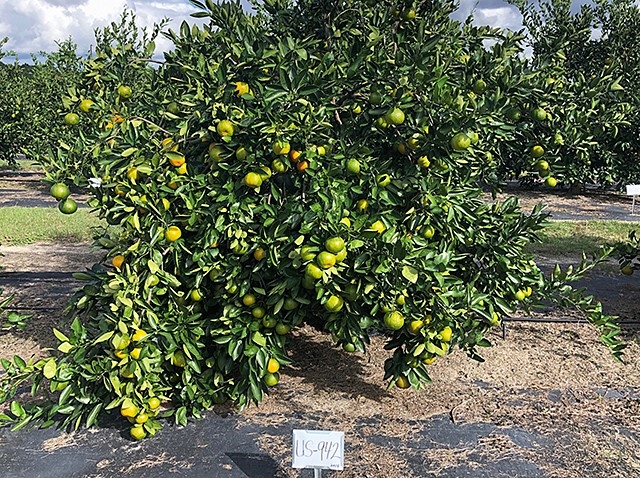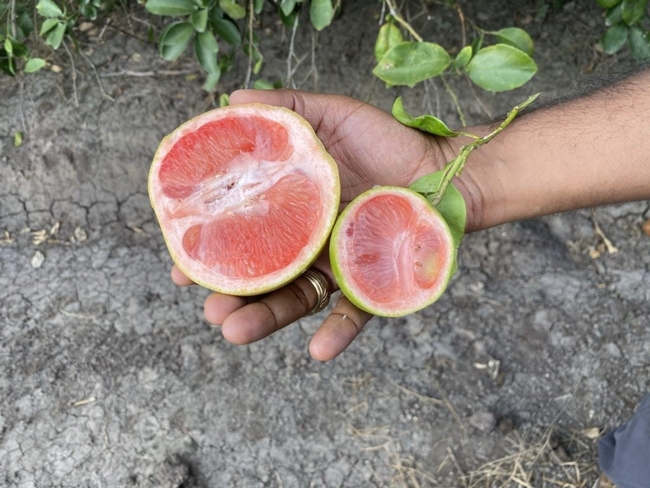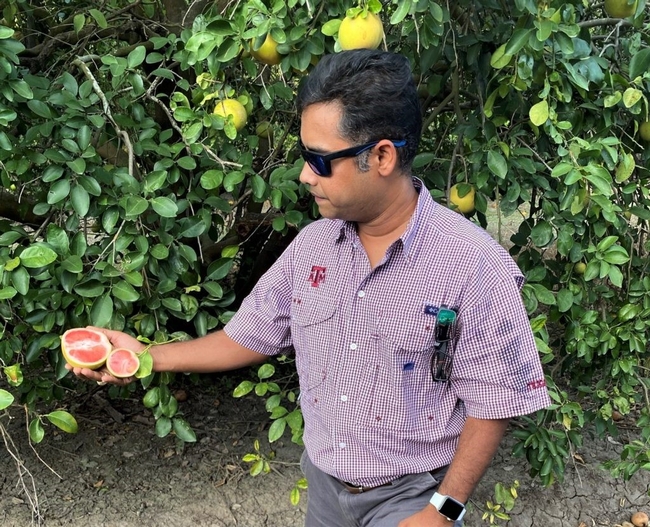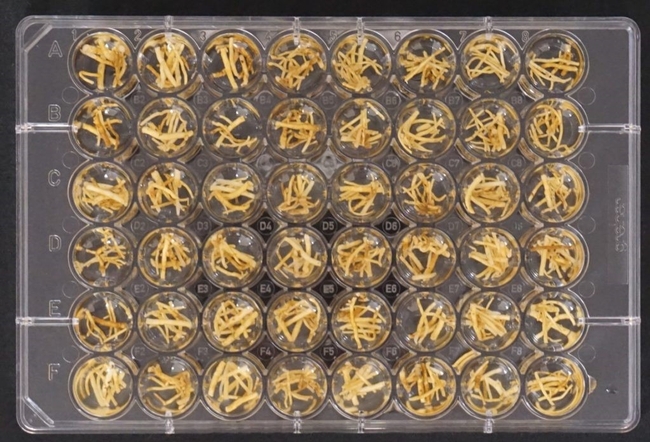- Author: Ben Faber
- Author: Ben Faber
Huanglongbing Update
As of November 5, a total of 2,619 trees and 368 ACP have tested positive via PCR for the bacterium that causes HLB. The most recent activity has been in Orange and San Bernardino counties. Infected trees have been or are being removed, additional HLB detection surveys and ACP treatments are applied on a recurring basis to remaining citrus in those areas.
For additional details, please see the updated HLB quarantine and treatment map and table at maps.cdfa.ca.gov/WeeklyACPMaps/HLBWeb/HLB_Treatments.pdf.
For information on regulatory and treatment requirements growers can expect should HLB be detected in or near your citrus grove or packing house, please refer to CDFA's Information for Citrus Growers/Grove Managers, Action Plan for ACP and HLB or this summary flyer.
Regulatory Update
Mustang Maxx has been approved for Spray and Harvest. For growers who harvest in one ACP Regional Quarantine Zone and pack in another, and use Spray and Harvest as their mitigation for moving bulk citrus, the list of approved ACP materials has been updated. The most recent list and protocols for quarantine compliance can always be found in the Information for Growers/Grove Managers document from CDFA. Please keep in mind this is separate and distinct from protocols and materials for Area Wide Management, discussed above.
Additional ACP/HLB Resources
- Check out the new and improved CDFA Citrus Division website: https://www.cdfa.ca.gov/Citrus/
- General ACP/HLB
oInformation on the state ACP/HLB program including maps, quarantine information, and a signup option for email alerts: citrusinsider.org/
oBiology of ACP and HLB, detection maps and recommendations for monitoring, eradication and management: ucanr.edu/sites/acp/
oUC IPM recommendations for ACP
oWeb-based map to find out how close you are to HLB: ucanr.edu/hlbgrowerapp
oVideo on Best Practices in the Field, available in English and Spanish
- Research
oUC Ag Experts Talk presentations on management of various citrus pests and diseases are available for viewing here and here on YouTube.
oSummaries of the latest research to combat HLB: ucanr.edu/sites/scienceforcitrushealth/
oScience-based analyses to guide policy decisions, logistics, and operations: www.datoc.us
- Regulatory/Quarantine
oSign up for program updates from the Citrus Pest and Disease Prevention Division at www.cdfa/signup-email-updates.
oRegulatory requirements for moving bulk citrus: Information for Citrus Growers
oSummary of regulatory requirements in the event of an HLB detection in commercial citrus: citrusinsider.org/Regulatory-Flyer
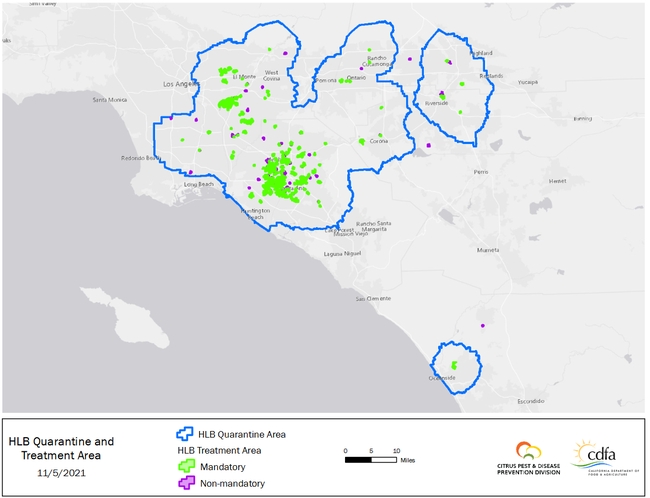
by koestoyo
University of Florida researchers publish award-winning findings on orange grove design to produce fruit under HLB
FORT PIERCE, Fla.— The American Society for Horticultural Science will honor University of Florida scientists for new guidelines citrus growers may apply to their operations. The researchers study ‘Valencia' orange production while trees are under the most serious citrus disease worldwide.
“The 7-year study broke new ground on data we provide to local citrus growers who remain in business despite huanglongbing, or HLB,” said Ronald D. Cave, Director of the University of Florida Institute of Food and Agricultural Science's Indian River Research and Education Center in Fort Pierce (UF/IFAS-IRREC).
A few of the findings citrus growers may employ immediately from the study are:
• High-density plantings produce more fruit—from 86% up to 300% more than trees not planted in high-density configurations under HLB.
• The study showed that advanced management practices that included high tree density, fertigation, and drip irrigation led to higher fruit yield.
• Additional research is needed to determine optimal fertilization rates for high-density sweet orange orchards under HLB-endemic conditions
The award-winning publication, “Sweet Orange Orchard Architecture Design, Fertilizer, and Irrigation Management Strategies under Huanglongbing-endemic Conditions in the Indian River Citrus District,” appears in the December 2020 issue science of the scientific journal HortScience. The paper describes the scientists' hypothesis, the entire research procedure, outcomes, and recommendations for further research.
Members of the American Society for Horticultural Science (ASHS) Fruit Publication Selection Committee wrote about the paper's significance. “Huanglongbing, also known as citrus greening, affects all citrus cultivars and causes serious tree decline. It is currently a major threat to the citrus industry. The results can influence the whole citrus industry to deal with HLB including orchard architecture design, fertilizer, and irrigation management strategies.”
Rhuanito “Johnny” Ferrarezi and his colleagues conducted experiments to determine the variables that promote healthy fresh fruit harvests with the presence of HLB. Ferrarezi, along with fellow professors Mark Ritenour and Alan Wright, will accept the “Outstanding Fruit Publication Award” for papers published in 2020 at the ASHS annual meeting awards ceremony in Denver, Colorado, Aug. 6. Ferrarezi is an Assistant Professor of Citrus Horticulture; Ritenour, Professor of Postharvest Technology; Wright, Professor of Soil and Water Science.
Others who contributed to the research and the award-winning publication are Arun D. Jani, a post-doctoral research assistant; Thomas James III, who manages citrus research groves; and Cristina Gil, an agricultural research assistant.
“We strive to keep citrus growers in business even though HLB is reducing the profitability of infected trees over time,” said Ferrarezi. “The point is to sustain younger trees for a number of harvests to produce the healthy, delicious fruit that made the Indian River District famous.”

- Author: Ben Faber

Commercial Citrus – How will the citrus grower manage the pest and disease in commercial groves?
The deadly huanglongbing (HLB) is spreading in California and threatens commercial citrus production. This website provides a map of where the Asian citrus psyllid (ACP) and HLB disease are located. Since there is currently no cure for the disease, the best management strategy is reducing the psyllid vector with insecticides and removing HLB-infected trees. This website provides a list of the ACP-effective insecticides, information about the best timing of their use & strategies for treatment.
Residential Citrus – What should I do to protect the citrus in my yard?
There is currently no cure for the huanglongbing (HLB) disease that kills citrus trees and is spread by an insect, the Asian citrus psyllid. It is estimated that 60% of Californians have at least one citrus tree in their yard, meaning that HLB may have a devastating effect in residential areas of California. Currently the only way to control the disease is to reduce the psyllid that spreads it and to remove trees that are infected or located near known infections. This website provides information about how near the insect and disease are to your home, and what you can do to help protect your trees.
How can I help educate the public on this very important subject?
This site has important resources for you to use to teach others about Asian citrus psyllid and huanglongbing.
Watch the 4-minute video below to learn what you can do to help control Asian citrus psyllid & HLB
Authors of this website are Dr. Matt Daugherty and Dr. Beth Grafton-Cardwell (retired) Extension Specialists in the Department of Entomology, UC Riverside, and Robert Johnson with UC Agriculture & Natural Resources, Informatics & GIS Statewide Program
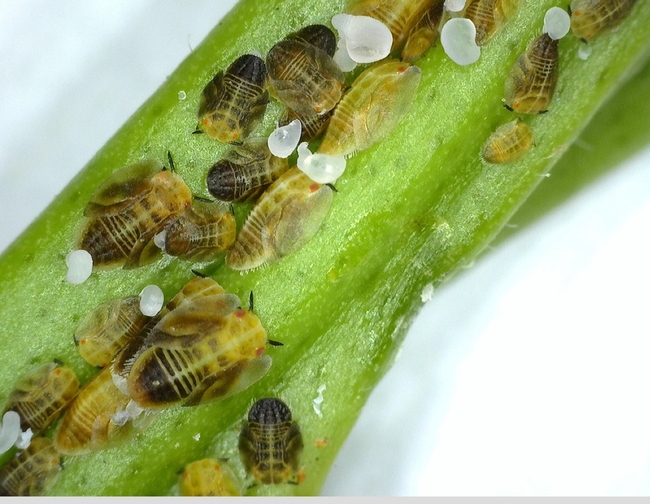
- Author: Ben Faber
ARS Citrus Rootstocks: A Success Story
The United Nations General Assembly designated 2021 as the International Year of Fruits and Vegetables. This issue of Down on the Farm takes a look at one of ARS's major contributions to fruit production: citrus rootstocks.
Remember that old commercial that declared, "A day without orange juice is like a day without sunshine"? Thanks to the Agricultural Research Service (ARS), consumers can enjoy "citrus sunshine" whenever they like. Begun by USDA more than a century ago, the citrus research program has helped to ensure a bounty of not only oranges, but also grapefruits, mandarins, lemons, and more.
Orange tree leaves with symptoms of Huanglongbing (HLB), also known as citrus greening disease. (Photo by Tim Gottwald, D2259-1)
But that bounty was severely threatened in 2005 with the appearance of a new and destructive disease. Citrus greening, or huanglongbing (HLB), has caused Florida citrus production to plummet around 70 percent in the 15 years since the disease hit U.S. citrus groves. HLB, which causes low yields, yellowed leaves, and bitter-tasting fruit, is caused by a bacterium, Candidatus Liberibacter asiaticus. So far, there is no cure.
Like other crops, citrus crops are susceptible to a variety of diseases and pests. One reliable way to fend off those threats is to graft the fruit-producing part of a tree (the scion) to the lower trunk and root system (the rootstock) of a different tree that has been bred to resist the disease or pest. Rootstocks are also used to obtain specific tree sizes, yields, and fruit quality, among other goals.
A 6-year-old Owari Satsuma Mandarin tree on US-942 rootstock developed by ARS. In this trial, US-942 was the highest yielding rootstock, averaging more than 300 pounds of fruit per tree. (Photo by Jake Price, University of Georgia, D4632-1)
With ARS's long history of helping growers keep their groves healthy and productive, the agency had the expertise required when HLB appeared. To quickly address the problem, the ARS citrus breeding project was refocused in 2005 partly to develop new, HLB-tolerant, highly productive citrus rootstocks.
Led by Kim Bowman, a plant geneticist in the ARS Subtropical Insects and Horticulture Research Unit in Fort Pierce, FL, the team released 12 new HLB-tolerant citrus rootstocks between 2007 and 2018. Before and after the releases, Bowman conducted dozens of field trials to evaluate and validate the rootstocks' performance, providing the scientific data needed to demonstrate their potential and gain industry acceptance. These rootstocks, all with the prefix “US,” have since become a key component in the survival of the Florida citrus industry.
ARS plant geneticist Kim Bowman in front of 5-year-old Valencia orange trees on HLB-tolerant rootstocks he and his colleagues developed. (Photo by Diane Helseth, D4631-1)
Not surprisingly, demand for the rootstocks was extremely high, and growers also needed assurances that they'd be getting the real deal. Bowman arranged for the plant material to be certified disease-free by the Florida Department of Agriculture, paving the way for the rootstocks to be commercially propagated on a large scale.
Bowman and his colleagues have also done a great deal of research on rootstock propagation. Even though most common citrus rootstocks can be grown uniformly from seeds, it takes several years for a young tree to produce a lot of seeds, and the seeds of many new rootstocks don't grow into true-to-type plants. The scientists have shown that using plant cuttings or tissue culture is an acceptable alternative to starting new rootstock trees from seed, and it's a much faster way to create hundreds of thousands of plants.
The use of these alternative methods has dramatically increased propagation for some of the new rootstocks, so that nurseries are not limited by seed supply.
From 2018 to 2020, the HLB-tolerant "US" rootstocks were used to produce nearly 3 million new citrus trees, or about 37 percent of all trees propagated in Florida. These rootstocks have also proven effective in areas affected by other diseases besides HLB. The rootstock "US-942" demonstrated the most consistent outstanding performance in field plantings and was the most popular rootstock in Florida from 2018 to 2020, with about 1.8 million trees propagated during that 2-year period, or about 22 percent of all propagations.
For more information, visit Citrus Rootstocks.—By Sue Kendall, ARS Office of Communications.
A 6-year-old Owari Satsuma Mandarin tree on US-942 rootstock developed by ARS. In this trial, US-942 was the highest yielding rootstock, averaging more than 300 pounds of fruit per tree. (Photo by Jake Price, University of Georgia, D4632-1)
